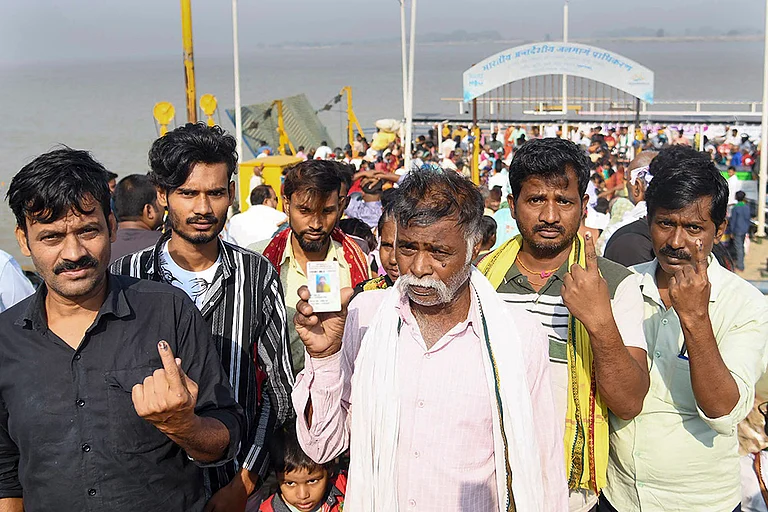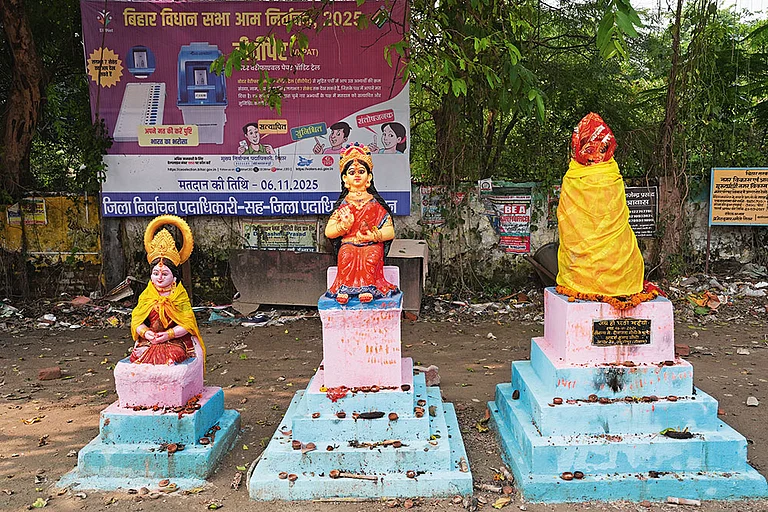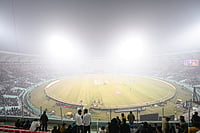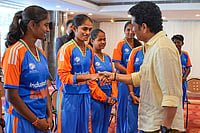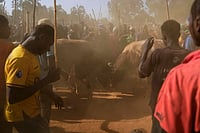
Women voters played a decisive role, driven by increased awareness and benefits from Nitish Kumar’s ₹10,000 Women Employment Scheme.
The return of migrants, fear of voter name deletion after the SIR process, and anti-incumbency sentiments all contributed to boosting overall turnout.
With 64.66 per cent turnout, the 2025 election marks Bihar’s highest-ever voter participation, signalling a new phase in its democratic engagement.
The first phase of polling for the Bihar Assembly Elections 2025 concluded on November 6 with a record-breaking 64.66 per cent voter turnout, according to a press note released by the Election Commission of India (ECI). The Commission described this as a historic figure — the highest ever in Bihar’s electoral history, surpassing the previous record of 62.57 per cent set during the 2000 Assembly elections.
Bihar has 243 assembly constituencies, and polling in the first phase was held across 18 districts covering 121 constituencies. The highest turnout was recorded in the Muzaffarpur constituency, where 70.96 per cent of eligible voters cast their ballots.
Experts attribute this surge in participation largely to the active role of women voters.
Women’s Enthusiasm at the Polls
Dr Devina Krishna, a professor at Patna Women’s College, believes this increase reflects growing civic awareness, particularly among women.
“The turnout clearly shows that women have participated enthusiastically in the election. Compared to the last election, this time there’s greater awareness about voting rights — especially among women. It’s a positive sign that citizens, particularly young women, are taking voting seriously. Social media has played a constructive role in spreading awareness of this issue. Many of my students who voted for the first time proudly posted selfies after casting their votes, inspiring others to do the same,” she said.
Dr Krishna herself arrived at booth no. 124 in Patna around 9 am with her mother, and both exercised their right to vote.
Cash Transfers and Electoral Motivation
Senior journalist Manikant Thakur agrees that women’s participation has been key to the high turnout, but he attributes it less to civic awareness and more to the Nitish Kumar government’s “Mukhyamantri Mahila Rozgar Yojana” (Chief Minister’s Women Employment Scheme). Under this scheme, ₹10,000 each was distributed to 7.5 million women across Bihar — just before the election announcement.
He argues that this financial assistance has had a tangible political impact.
For instance, Meena Devi, a resident of Saipneri village in Khijarsarai block, Gaya district, used the ₹10,000 she received to buy two goats. On the eve of polling, she told reporters, “We will vote for Nitish Kumar’s party only. Nobody can change our minds now. I had long wanted to buy goats, but didn’t have the money. This government scheme solved my problem.”
Senior journalist Manikant Thakur, “The ₹10,000 transfer has had a stronger effect among women than the Mahagathbandhan’s (Grand Alliance) promise of government jobs. If women turned out in large numbers, the NDA stands to gain, just as in 2020, when high female turnout correlated with NDA victories. Conversely, seats with higher male turnout tended to benefit the Mahagathbandhan.”
However, he also points out other contributing factors to the turnout spike — such as the presence of returning migrants during the festival season and the inclusion of new voters after the Special Intensive Revision (SIR) of electoral rolls. He also credits Nitish Kumar’s long-running women-centric welfare schemes as a key influence.
Despite these trends, Thakur cautions that the contest between the NDA and the Mahagathbandhan remains a closely fought one.
Voter Demographics and Polling Scale
According to the final electoral roll released after the SIR process, Bihar has 7.42 crore (74.2 million) registered voters — comprising 3.92 crore men, 3.49 crore women, and 1,275 third-gender voters.
In the first phase, voting was conducted across 45,341 polling stations for 3.75 crore eligible voters — comprising 1.98 crore men and 1.76 crore women.
A total of 1,314 candidates contested in this phase — 1,192 men and 122 women.
Bihar’s Women Continue to Lead Voter Turnout in Elections
Notably, in the 2020 Bihar Assembly Elections, female turnout (59.7 per cent) had already surpassed male turnout (54.6 per cent).
Looking at Bihar’s voting trends since 1990: 1990 – 62.04 per cent, 1995 – 61.79 per cent, 2000 – 62.57 per cent
Feb 2005 – 46.5 per cent; Oct 2005 – 45.85 per cent; 2010 – 52.73 per cent; 2015 – 56.91 per cent; 2020 – 57.29 per cent.
The 2025 figure of 64.66 per cent now stands as the highest voter turnout in Bihar’s electoral history, marking a decisive moment shaped by women’s assertive political participation, welfare-driven mobilisation, and renewed civic consciousness.
The Migrant Factor in Bihar Elections
Observers also note the role of migrant labourers, who typically travel to Punjab and Haryana for harvesting in May but return to Bihar around October–November for the paddy harvest after Chhath Puja. Many of them, being back home, may have participated actively in voting this time.
Post-Bihar SIR Anxiety and Anti-Incumbency Effect
During the SIR process, widespread political turbulence led to speculation and anxiety among voters that their names might be deleted from the electoral rolls. Many analysts believe this fear motivated people to turn out in larger numbers.
Senior journalist and election analyst Surur Ahmad supports this view.
“Many studies suggest that voter turnout rises during anti-government or anti-incumbency waves. I’m not saying that’s necessarily the case here, but it’s a known pattern. In Bihar’s case, the fear that their names could be struck off the rolls after the SIR exercise likely pushed many habitual non-voters — especially those living outside the state — to vote this time,” he said.
Ahmad draws a parallel with the 1995 Bihar elections, when Election Commissioner T.N. Seshan’s strict enforcement led to a similar surge in voter participation among women, backward castes, Muslims, and Dalits — groups who had previously stayed away from the polls in large numbers.
The first phase of the 2025 Bihar Assembly elections marked a historic 64.66 per cent voter turnout — the highest in the state’s electoral history. Analysts credit this surge to women’s active participation, spurred by increased awareness, long-running welfare schemes, and recent cash transfers under the CM’s Women Employment Scheme.
Factors such as the return of migrant voters, fear of name deletion after the SIR process, and anti-incumbency sentiment also played a role. With women once again emerging as decisive voters, this election underscores a deeper social shift — where welfare, awareness, and empowerment are reshaping Bihar’s political landscape.









